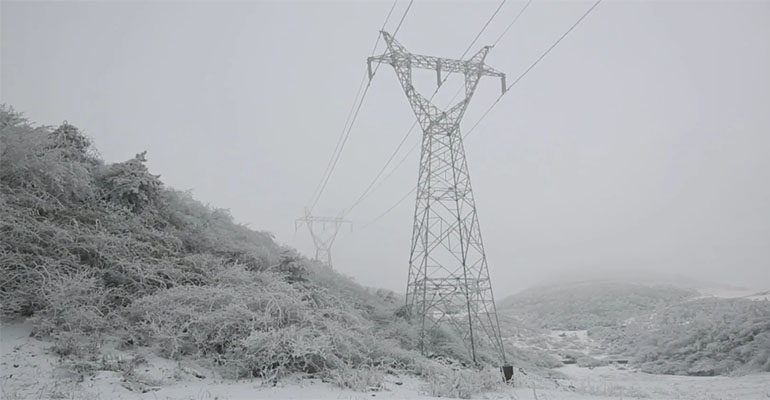- Offices Time:24 Hours Online
- Email:[email protected]
- WhatsApp:+8618339938759

Posted on December 12, 2022
Danger of low temperature weather to overhead transmission lines
For low-temperature weather such as wind and snow, it is best to use overhead insulated cables with insulating layers, or to insulate the cables to prevent severe cold weather from affecting the normal operation of the cables.
As we all know, the electric energy generated by the power plant is not directly transmitted to the customer’s power consumption end, but is stepped up and down, and then sent to all levels of power users through a long transmission line. Considering various factors such as environmental pollution and economy, power plants are mostly built in remote areas that are inaccessible, so many overhead transmission lines are built in mountainous areas, which are also the areas that are most likely to be covered with ice when cold waves come. When the natural temperature drops below 0 degrees and encounters humid weather, ice will appear on the cable. When the weight exceeds the expected load-bearing capacity of the pole design, electrical accidents such as the collapse of the pole and tower will occur. It is also partly due to the problems caused by the rise in electricity consumption of urban residents due to the sudden drop in temperature.
Do you know the accidents caused by ice and snow on overhead transmission lines?
- Overload, that is, the icing of the conductor exceeds the design anti-icing thickness, resulting in an increase in the mass and wind pressure area of the icing conductor and causing an accident. At the same time, it will also cause mechanical damage, including damage to hardware, broken strands of wires, damage to towers, overturning of insulator strings, and cracking. Icing also increases the sag of the line, causing flashover and burns, and burning the wires.
- Uneven icing or out-of-schedule deicing accidents. Uneven icing of adjacent gears or different periods of deicing of lines will produce tension differences, resulting in wire breakage, insulator damage or rupture, tower cross-arm twisting or deformation, wire and insulator flashover, and wire electrical clearance reduction resulting in flashover Wait.
- Ice-coated wire galloping accident. When the conductor is covered with ice and is asymmetrically covered with ice, galloping is easy to occur in the line. The conductor with large cross-section is easier to gallop than the conductor with small cross-section, and the split conductor is easier to gallop than single conductor. The movement trajectory of conductor galloping is approximately elliptical when viewed along the line direction. Due to the large magnitude of galloping and the long duration, it may cause phase-to-phase flashover, damage ground wires, conductors, fittings and other components; Serious accidents such as line collapse and tower collapse.
- Insulator ice flash accident. Ice coating can be regarded as a special kind of pollution. The existence of ice coating changes the electric field distribution of insulators, and when the ice contains conductive impurities such as pollution, it is more likely to cause ice flash.

Therefore, ice and snow are still very harmful to transmission lines. The conditions for icing to occur are special meteorological conditions that occur when the air humidity is high and the temperature is around 0°C, and it is more common in areas near water. One possibility is that the snow on the wires freezes, and the other is that the snow on the ground is blown up by strong winds and re-condenses on the wires, sometimes very seriously.
Of course, since icing can cause electrical accidents, there must be a solution to this problem. In the past, due to the limitations of technical means, the main method of power maintenance was manual ice breaking. With the continuous development of technology, the anti-icing reinforcement work of power transmission and distribution lines in ice areas has been vigorously carried out.
The anti-icing design level of the lines is above 20 mm, and the anti-icing level of the rod section in the heavy ice area is as high as 50 mm. The lines of 35 kV and above are reinforced to improve the anti-icing level. Porcelain cross-arm and other methods have improved the anti-icing level of the line. And most of the ice-covered areas have installed ice-covered monitoring devices, which can accurately and timely judge damaged lines. Now at home and abroad, most of them use thermal deicing methods, one is to change the grid structure and use the thermal effect of the load current to deice, and the other is to use one end short circuit and one end to supply power to increase the line load to melt ice. The de-icing equipment in Canada’s Luvis substation is the world’s first DC technology de-icing equipment.
Post categories
Most Popular Posts
-
The 136th Canton Fair welcomes you to participate!
October 12, 2024 -
High temperature cable introduction
July 26, 2024 -
Kenya Power and Energy Exhibition 2024
June 11, 2024 -
Introduction of rubber sheathed cable
June 5, 2024





